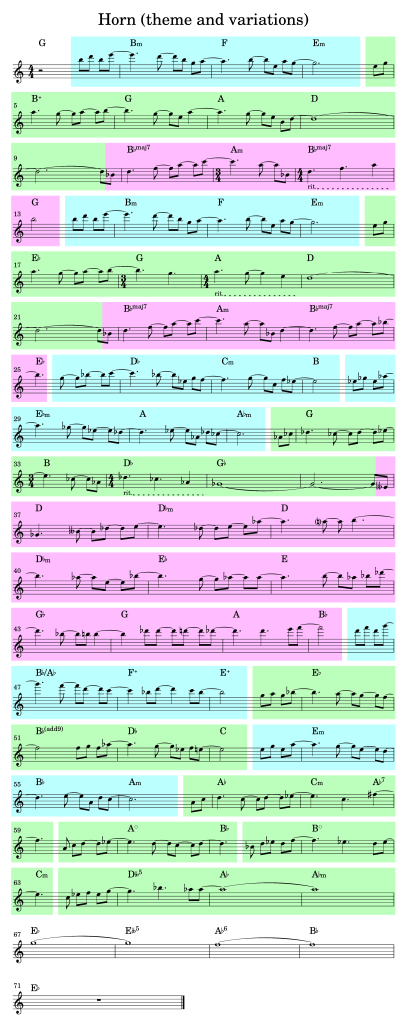A mashup featuring The Smiths and the Trammps. Happy birthday, Morrissey!
CHIRP* No. 13
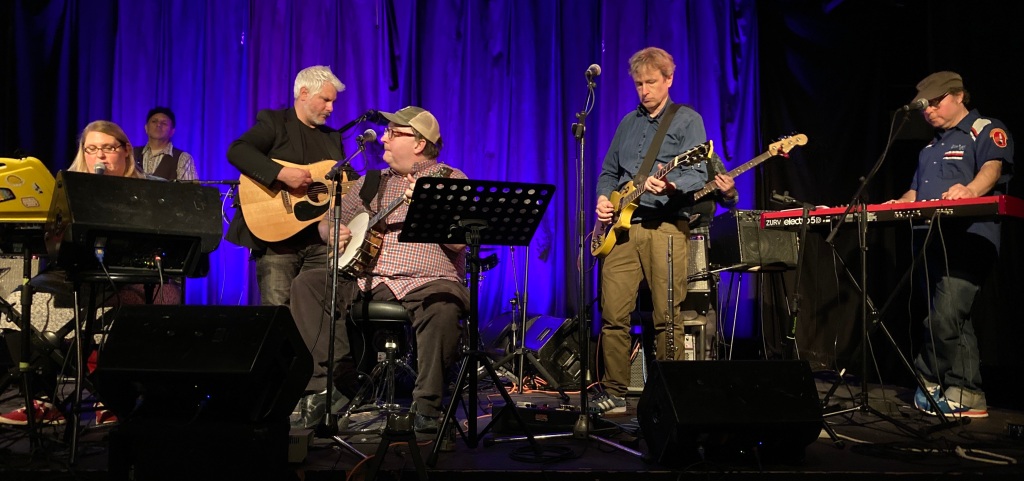
Recently shuttered venue. Nine refined musicians crammed onstage. Immaculate mix, not too loud. Mounted cameras plus roving lensman. Invitation-only audience, mostly players themselves. Silly banter to keep things loose. No taboo against restarting songs after flubs. Comfortable.
(King Radio at the Divine Theater, Holyoke, Mass., 4/3/24)
* Concise Historical Impression of a Recording or Performance.
Counting Phish’s ‘Mound’
A quick post to set the record straight.
On Reddit someone’s posted an overcomplicated guide to the polyrhythmic drum intro on Phish’s “Mound” (from “Rift,” 1993). Here’s the real deal:
3 bars of 6/4
1 bar of 4/4
1 bar of 5/4
1 bar of 4/4
The form repeats three times. The snare always lands on beat 4, regardless of the time signature. The handclaps provide a frame of reference, staying in 6/4 time throughout and always falling on the 4.

Related

Assertively resigned, resignedly assertive
The Phish song “Horn” features theme and variations worthy of any classical composer.
Of Fires, Rings, and Lakes
A mashup featuring Johnny Cash, Nirvana, and the Meat Puppets. Happy birthday, Johnny!
Restrained transgression

Songs that strictly color within the lines have no appeal, but indiscriminate scribbling is hardly the answer.
Every now and then, you’ll come across a page in the coloringbook of pop music where someone has put the wrong color in just the right place. What might have been a perfectly neat but bland time-killer is instead worthy of framing.
“No One Else on Earth” opens with a very basic chord progression. If you played it on a piano, you’d be using only the white keys. Wynonna is singing about how she fences off her heart, and the music reflects this stable but dull existence.
Then comes the pre-chorus, where love sneaks in under the wire. Two black keys are brought into play—just for two quick beats. In our coloringbook, a boundary has been crossed. But the colorist could not be accused of getting carried away. This is a restrained, surgical transgression.
In fact there are two other places in the song structure where nonstandard chords are used, and for longer durations. But, after that first exquisite stab of chromaticism, they’re not surprising. It’s all part of a design the coloringbook-maker never even contemplated.
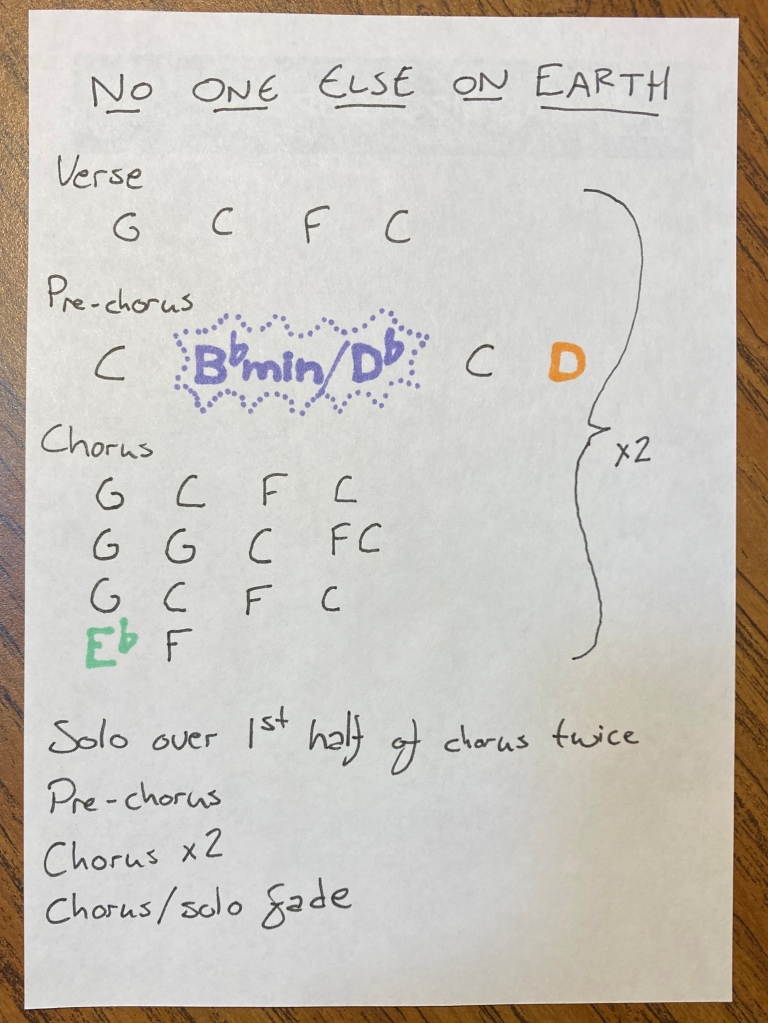
Albums not of 2023

The best albums I’ve discovered in the past year or so all came out several years prior. They’re listed in alphabetical order by artist. If these records have anything in common, it’s varying degrees of rough-hewedness. Apparently what my ear has been drawn to lately has not been ProTools perfectionism.
Danny Brown – Atrocity Exhibition (2016)
Sort of the Bone Machine of hip-hop. I listened a few times and decided I didn’t like it — Danny’s nasal delivery and druggy lyrics put me off. But then I couldn’t stop thinking about it. Each time I give it one last chance, I find more to like.
Feist – Metals (2011)
Melancholy, introspective songs with off-kilter, retro production. Dreary but somehow comforting. Perfect rainy day listening.
Low – The Curtain Hits the Cast (1996)
Spellbinding in its slowness and simplicity and scruffiness. It leaves alone a lot of the imperfections that get airbrushed out of most records. The result is intimacy and immediacy. That’s essential: songs this sparse would turn sterile with too much studio intervention.
Tripping Daisy – Jesus Hits Like the Atom Bomb (1998)
I thought of this band as a one-hit wonder, thanks to their 1995 song “Piranha,” which concludes with probably the lamest guitar solo ever recorded. But their overlooked followup album is mature and ambitious. (Hat tip to Talking Heads tribute band Start Making Sense, who turned me on to “Jesus Hits” this fall when they announced they would be covering it.)
Related
Where titles come from
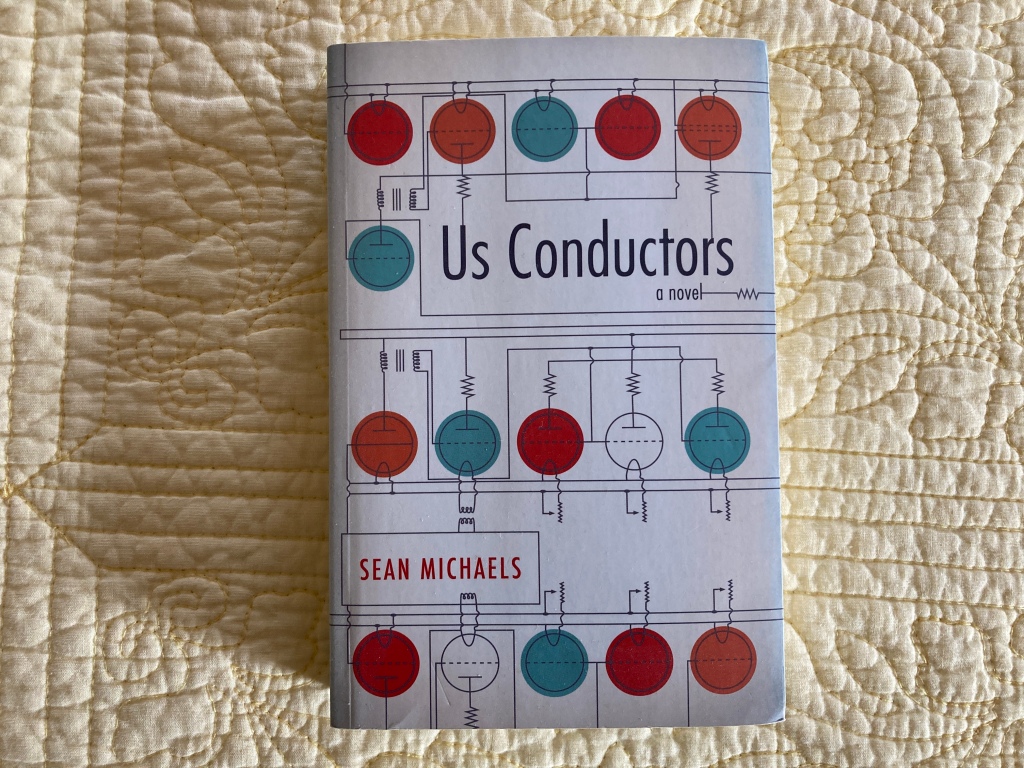
Welcome to the first installment of the Zögernd Bookpile, where sounds are summoned from the silence of the printed page.
We begin with “Us Conductors,” a 2014 novel that imagines theremin inventor Lev Termen as a reluctant spy for the Soviet Union and practitioner of kung fu. Its subtitle: “In which I seek the heart of Clara Rockmore, my one true love, finest theremin player the world will ever know.”
Given the diagram on the cover, I take the title to be a reference to conductors of electricity — not only the components within the theremin but also the performer’s body, which interacts with the instrument’s electrical field. This performer gestures with both arms to create sounds, a bit like the conductor of an orchestra.
Author Sean Michaels has said the chapter titles in “Us Conductors” are the titles of new wave rock songs of the 1980s — “Music that’s really beautiful and noisy — that was the kind of feeling I was trying to carry through.” With minimal detective work I matched every title to an artist and assembled the following playlist. The only mystery is Part I, Chapter 6: “Closer.” That’s the title of a Joy Division album, but not a song from that band or era or genre, as far as I can tell.
These songs are anachronisms for a book set in the early 20th century. But throughout the narrative are references to several era-appropriate pieces of music — mostly short classical works, a lot of them performed on theremin by either Lev or Clara. Here’s another playlist.
The final composition mentioned in the book is “Bolero” (1928) by Maurice Ravel. My favorite version of this particular piece is done on the Moog synthesizer, a nephew of the theremin.
Only the beginning of endings
Classical Music Diary No. 14
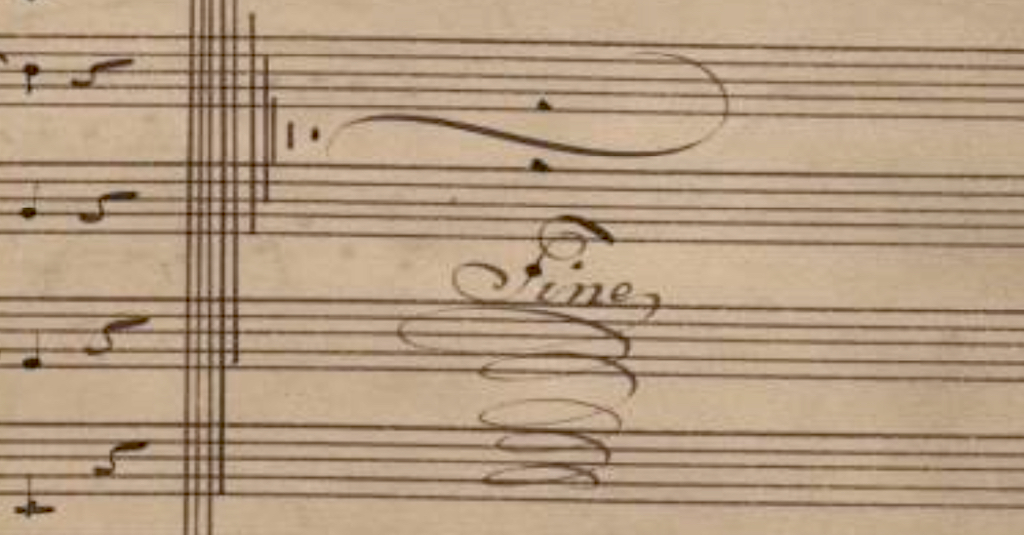
The uniformity of endings in classical music has been bothering me. Every piece seems to conclude with multiple soundings of the tonic chord. Composers will sometimes dress up these bits of aural clipart with rhythmic flair, but in most cases they stick to the dogma.
For an example, I’ll pick on “Sinfonietta” (1873) by German-Swiss composer Joachim Raff — mostly because I’ve been listening to it a lot since hearing the Holyoke Civic Symphony perform it last fall. The diminutive title is appropriate both for the length of the piece (about 25 minutes) and the stripped-down orchestra of woodwinds and French horns.
Each of the four movements is interesting, but they all conclude in the most predictable way. The first and fourth movements, in the home key of F Major, end with F chords struck multiple times. The third movement, in the dominant key of C Major, puts a C chord through descending inversions before hammering it home. By comparison, the second movement’s ending is adventurous: The tonic chord, F minor, is placed on either side of an outside-the-key C Major chord. Each time I listen, I think, Couldn’t Raff come up with anything better?
I often think back on Arthur Rubinstein’s recording of the scherzo from Frédéric Chopin’s “Funeral March” sonata. The pianist plays the movement’s final two notes in a way that I can only describe as offhand. Is he as bored with endings as I am?
Assertively resigned, resignedly assertive

The jam band Phish isn’t all jamming. A handful of their songs are rigorously composed from beginning to end, some following theme-and-variations frameworks worthy of any classical composer.
No member of this subset of Phish songs is more beautifully constructed or poignant than “Horn,” which the band has been playing live since 1990 and which appears on their 1993 studio album “Rift.”
It starts like a regular rock song, with a sturdy riff. Enigmatic backing vocals enter: “Rhine wine, car horn.” Then begins a verse about a toxic relationship:
Now that you’ve deceived me
and played my around
and hung those nasty flyers
on all the buildings in town,
dribbled my possessions
in a ring around the earth,
and bought and sold my self-control
for less than it was worth
The narrator seems to be working up to an assertive statement along the lines of, “It’s over.” But he doesn’t quite make it there. After more of the riff, he continues resignedly:
Now I know the reason
that I’m feeling so forlorn.
I’ll pick you up at 8 as usual.
Listen for my horn.
The horn is his car horn, confirmed by the backing vocals and imitated by the beep-beep double strum that ends each repeat of the riff. As an astute forum commenter points out, it’s probably also the horn of a cuckold. Could it be the vessel holding the Rhine wine, too?
If the lyrics are the narrator apostrophizing his perfidious lover, then the long instrumental passage that follows is his tortured inner monolog, where he cycles through several conflicting emotions on his way to pick her up.
The passage is built on two contrasting themes: We could label one the voice of sentimentality and the other the voice of skepticism. Both themes go through variations as the two voices within the protagonist challenge one another.
The first theme is itself made up of two shorter phrases, each conforming to the minor pentatonic scale. The first, sad and subdued, is an acknowledgement by our hero that he has been wronged.
Theme 1, Phrase 1.

The second phrase is brighter, revealing that the protagonist still holds out hope for the relationship.
Theme 1, Phrase 2.

The two melodic phrases combine into a theme that seems to say, “She done me wrong, but remember how good it used to be?”
What follows in Theme 2 is a word from the narrator’s own better judgment. This statement is blunt. While Theme 1 takes up more than eight measures, Theme 2 gets its point across in fewer than four. It seems to say, “Dude, time to move on.”
Theme 2.

The two themes go back and forth for 71 measures — or about two minutes, more than half the song’s total running time. In that space they are restated, expanded, modulated, reoriented. Most of all they gain in vehemence. Nearing the end, one gets the impression that the protagonist has screwed up his courage. But the long, sustained notes that conclude the instrumental seem to ask a simple, melancholic question: “why?”
Finally the riff and backing vocals return as an outro. What will our hero do when his lover gets in the car?
A note on the score: I’m indebted to Chris Emmerson, whose excellent guitar transcription made this project so much easier. I was on my own figuring out the piano chords, although MrSteevt provided clues. The accompaniment is built around a chromatic line that rises and falls (mostly falls) much like the protagonist’s spirits.
More theme and variations from Phish:
“My Friend, My Friend” (1993): 0:00-2:26
“Guelah Papyrus” (1990): 2:01-3:57
“All Things Reconsidered” (1993): the whole song
‘Albums’ of the ‘year’ 2021
Continuing a Zögernd tradition, here I encapsulate the top bodies of musical work to debut in my ears during our latest revolution around the sun.
Johannes Brahms – Ein deutsches Requiem, nach Worten der heiligen Schrift (1868)
Full of frisson-inducing placid beauty but also some absolute bangers. Notice how so many of the notes last longer than you’d expect them to. I wrote a little more about the piece here.
Sam Cooke – Night Beat (1963)
The guitar leads are kind of terrible. But if this album were too perfect we’d probably die hearing it.
The Cramps – Psychedelic Jungle (1981)
Campy vocal delivery, primitive riffs, facemelting snare delay — just the things to get you through the pandemic malaise.
Deerhoof – Milk Man (2004)
Mathy and weird but also fun and accessible. Just go with it.
Antonín Dvořák – Symphony No. 9 (“From the New World”) (1893)
Exciting, memorable melodies from wall to wall. Real meat-and-potatoes stuff. A wrote a little more about it here.
Landowner – Impressive Almanac (2017)
A proof of concept for the live band that followed, but I like the lo-fi/drum machine aesthetic best.
Norma Tanega, “Walkin’ My Cat Named Dog” (1966)
Perfectly imperfect performances of inventive, heartfelt songs from folk ballads to gospel stomps and even a march.
